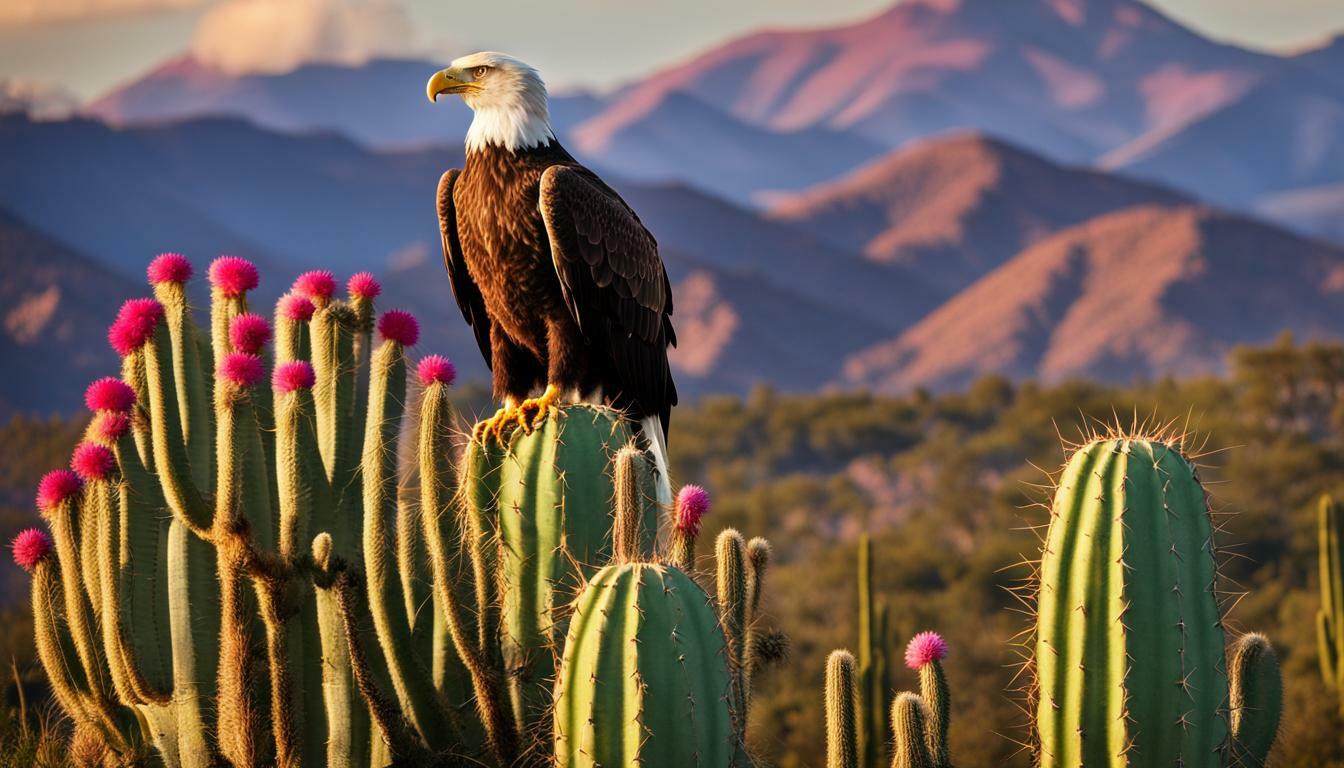If you’re interested in wildlife conservation, you may be wondering about the legal status of bald eagles in Mexico. As one of the most iconic birds in North America, bald eagles are highly valued for their beauty and cultural significance. However, they also face numerous threats, including habitat loss, pollution, and illegal hunting. That’s why it’s important to understand the legal framework in place to protect bald eagles and promote their conservation in Mexico.
Key Takeaways
- Bald eagles are classified as an endangered species in Mexico, highlighting the need for conservation efforts.
- Mexico has specific laws and regulations in place to protect bald eagles, with penalties for violating these laws.
- Collaborative efforts between Mexico and the United States have been successful in promoting bald eagle conservation.
The Conservation Status of Bald Eagles in Mexico
Bald eagles are an iconic species in North America, and their conservation status in Mexico is a matter of great concern. While the population of bald eagles in Mexico is relatively small compared to the United States and Canada, these birds play a crucial ecological role in their local ecosystems.
The Mexican government has classified bald eagles as an endangered species, and their conservation is a top priority. However, the population of bald eagles in Mexico is threatened by habitat loss, pollution, and unsustainable human activities.
The Population and Habitat of Bald Eagles in Mexico
The population of bald eagles in Mexico is estimated to be less than 150 individuals, with most of them concentrated in the northern region of the country, particularly in the states of Chihuahua, Sonora, and Baja California. Bald eagles in Mexico depend on a variety of habitats, including forests, rivers, wetlands, estuaries, and coastal areas.
However, the habitat of bald eagles in Mexico is threatened by human activities such as mining, logging, agriculture, and urban development. The degradation and fragmentation of their habitat pose a significant threat to the population of bald eagles in Mexico.
The Threats to Bald Eagles in Mexico
The population of bald eagles in Mexico faces a range of threats that undermine their survival. One of the most significant challenges is habitat loss and fragmentation, which reduces the availability of suitable nesting sites, prey, and breeding habitat.
Bald eagles in Mexico are also exposed to pollution, particularly from agricultural runoff, urban waste, and industrial discharges. These pollutants can contaminate their habitat and food sources, leading to health problems and reproductive issues.
Other threats faced by bald eagles in Mexico include illegal trapping, hunting, and trade, as well as collisions with power lines, wind turbines, and vehicles. Climate change is also likely to affect bald eagles in Mexico, as it alters their habitat and reduces the availability of prey.
The Conservation Efforts for Bald Eagles in Mexico
The Mexican government, NGOs, and local communities are working together to conserve bald eagles in Mexico and their habitat. The conservation efforts include habitat restoration, anti-poaching campaigns, public awareness and education programs, and research and monitoring initiatives.
One of the most successful conservation efforts for bald eagles in Mexico is the conservation program implemented by the Natural Protected Areas Commission (CONANP). The program aims to protect critical habitats for bald eagles, such as the El Pinacate Biosphere Reserve in Sonora, and to promote sustainable tourism as a means to support the conservation of these birds.
Other conservation initiatives for bald eagles in Mexico include partnerships between Mexico and the United States, such as the Trilateral Committee for Wildlife and Ecosystem Conservation and Management, which focuses on conservation and management of shared biodiversity.
Overall, the conservation efforts for bald eagles in Mexico are crucial to the survival and recovery of this species. The protection and conservation of these birds and their habitat are essential for the ecological integrity of Mexico’s landscapes and ecosystems.
Mexican Laws Protecting Bald Eagles
Now that you know about the conservation status of bald eagles in Mexico, you may be wondering what laws are in place to protect them. Mexico has a range of legal protections for this iconic bird, including both federal and state laws.
The Mexican government recognizes the importance of bald eagles as a symbol of national heritage and has designated them as a protected species. This means that it is illegal to kill, capture, or trade bald eagles or their parts without a permit from the government.
The main federal law protecting bald eagles in Mexico is the General Law of Ecological Equilibrium and Environmental Protection. This law prohibits any activities that could harm or destroy the natural habitats of protected species, including bald eagles. The law also establishes penalties for those who violate its provisions, ranging from fines to imprisonment.
In addition to federal law, several states in Mexico have their own protections for bald eagles. For example, the state of Chihuahua has established protected areas where the birds can nest and feed undisturbed. The state of Jalisco has implemented a program to monitor bald eagle populations and protect their habitats.
The Mexican government also collaborates with international organizations, such as the Convention on International Trade in Endangered Species of Wild Fauna and Flora (CITES), to regulate trade in bald eagles and their parts.
By putting these regulations in place, Mexico is taking steps to ensure the long-term survival of bald eagles in their country. However, there is still work to be done to fully protect these birds and their habitats from the many threats they face.
Conservation Efforts for Bald Eagles in Mexico
In order to protect the endangered bald eagle population in Mexico, various conservation efforts are in place, involving government agencies, NGOs, and local communities.
| Initiative | Description |
|---|---|
| National Eagle Conservation Program (PRONACE) | A joint effort between the Mexican government, NGOs, and local communities to protect and conserve the country’s eagle population, including the bald eagle. The program includes monitoring, habitat restoration, and public awareness campaigns. |
| The Alliance for Zero Extinction (AZE) | A global initiative aimed at conserving the world’s most threatened species and their habitats, including the bald eagle in Mexico. The alliance works with local partners to identify and protect critical habitats. |
| Conservation and Monitoring Program | A research and monitoring program conducted by the Mexican government to track the population and habitat of bald eagles in the country. The data collected helps inform conservation strategies. |
These initiatives have already shown success in conserving the bald eagle population in Mexico. In 2010, the species was downlisted from endangered to threatened thanks to the efforts of these conservation programs.
Citizens’ Participation in Conservation
Local communities play a crucial role in bald eagle conservation efforts in Mexico. Through education and engagement programs, citizens are informed about the importance of the species and the need for their protection.
One example of these programs is the “Adopt a Nest” initiative, which allows individuals and communities to actively participate in the conservation of bald eagles. Participants monitor nests, report any threats or disturbances, and contribute to habitat restoration efforts.
This collaboration between the government, NGOs, and local citizens demonstrates the importance of a collective effort in ensuring the survival of the bald eagle in Mexico.
Threats to Bald Eagles in Mexico
Despite their protected status in Mexico, bald eagles face a number of threats that endanger their survival.
| Threats | Description |
|---|---|
| Habitat loss | The destruction and alteration of bald eagles’ critical habitat due to human development, logging, agriculture, and mining activities. |
| Pollution | The accumulation of toxic chemicals such as lead, mercury, and pesticides in the environment and food chain. These contaminants can cause a range of health problems for eagles, including reproductive failure, weakened immune systems, and death. |
| Illegal wildlife trade | The illegal capture, trade, and sale of bald eagles for their feathers, talons, and other parts, which are highly valued in traditional and cultural practices. |
| Human disturbances | The disturbance and harassment of bald eagles by humans, particularly during breeding and nesting periods, which can cause stress, abandonment, and reduced reproductive success. |
These threats have led to a decline in the bald eagle population in Mexico, with only an estimated 70 to 130 breeding pairs remaining.
It is crucial that conservation efforts continue in order to mitigate these threats and ensure the long-term survival of the bald eagle in Mexico.
Stay tuned for the next section on monitoring and research on bald eagles in Mexico.Monitoring and Research on Bald Eagles in Mexico
Scientific research and monitoring efforts play a crucial role in the conservation of bald eagles in Mexico. Through monitoring their behavior, habitat use, and population, researchers can gain valuable insights into the specific threats facing these birds and inform conservation strategies to address them.
One notable effort is the Mexican Network of Bird Banding, a collaborative project between government agencies, NGOs, and universities to monitor bird populations and movements. This project has helped track the movements of bald eagles and identify important nesting areas.
Another initiative is the use of satellite tracking to study the migration patterns and wintering locations of bald eagles. This research has revealed the importance of protecting critical habitats in Mexico where these birds spend the winter months.
Challenges in Researching Bald Eagles
Despite these efforts, researching bald eagles in Mexico can be challenging due to the rugged terrain and remote locations where they live. Additionally, funding for research and monitoring programs can be limited, highlighting the need for continued support and resources.
Nonetheless, ongoing research and monitoring efforts provide valuable information for guiding conservation efforts and ensuring the continued survival of bald eagles in Mexico.
Collaborative Conservation Initiatives
Collaborative efforts between Mexico and the United States have been key in the conservation of bald eagles in Mexico. Through joint research projects and information sharing, both countries have been able to better understand the behavior and habitat of these majestic birds.
In addition, conservation agreements have been made between the US and Mexico to ensure the protection of bald eagles. These agreements have created a framework for both countries to work together in monitoring and enforcing the laws that protect these birds, which has helped to combat illegal wildlife trade and other threats they face.
Collaborative research projects
One of the most significant collaborative efforts has been the research project conducted by the US Geological Survey in partnership with Mexican organizations. This project aimed to study the breeding ecology of bald eagles in Mexico and to assess the impact of threats on their population.
The study involved monitoring bald eagle breeding pairs in different regions of Mexico, collecting data on their nesting behavior, diet, and reproductive success. The research helped to identify critical habitats for bald eagles and informed conservation strategies for their protection.
Information sharing
Information sharing has also been crucial in the conservation of bald eagles. The Mexican government regularly shares data on bald eagle populations and habitat with their US counterparts. This has helped to inform research and conservation efforts in both countries.
Furthermore, the US Fish and Wildlife Service has been providing technical support to Mexican authorities in the enforcement of laws that protect bald eagles. This includes sharing best practices in monitoring and prosecuting wildlife violations, as well as providing training for law enforcement officials.
Conservation agreements
The US and Mexico have signed several conservation agreements that aim to ensure the protection of bald eagles. One such agreement is the Migratory Bird Treaty Act, which prohibits the take, possession, and sale of migratory birds, including bald eagles.
In addition, Mexico has created several protected areas that are critical habitats for bald eagles. These areas are managed in collaboration with local communities and NGOs, which has helped to ensure the long-term protection of these birds and their habitats.
Public Awareness and Education Programs
As a responsible traveler, you can make a significant contribution to bald eagle conservation efforts in Mexico by learning about their habitat, behavior, and challenges. By spreading awareness and educating others on the importance of protecting these iconic birds, you can help promote their conservation and ensure their survival in the wild.
There are several public awareness and education programs aimed at promoting bald eagle conservation in Mexico. These programs provide information on the threats eagles face and how individual actions can help protect them in the long run. You can participate in birdwatching tours, attend talks and lectures, and view educational exhibits to learn more about bald eagles and their conservation.
Local community engagement is also a crucial aspect of promoting public awareness and education. By collaborating with local communities, conservationists can gain valuable insights into the cultural significance of bald eagles and tailor their interventions accordingly. Community-led conservation initiatives can also help build awareness and foster a sense of stewardship towards these magnificent birds.
By supporting public awareness and education programs, you can help promote the conservation of bald eagles in Mexico and ensure their survival for generations to come.
Sustainable Tourism and Bald Eagle Conservation
Mexico is home to some of the most beautiful and unique wildlife in the world. With increasing interest in ecotourism, responsible wildlife watching practices play an important role in the conservation of these precious species.
Sustainable tourism initiatives in Mexico have been instrumental in promoting bald eagle conservation. By implementing responsible wildlife watching practices, ecotourism projects provide opportunities for visitors to learn about these majestic birds while minimizing disturbances to their natural habitat.
Visitors can support bald eagle conservation efforts in Mexico by choosing responsible tour operators, following wildlife observation guidelines, and avoiding activities that could cause harm to the birds or their habitat.
| Sustainable Tourism Practices for Bald Eagle Conservation in Mexico |
|---|
| Choose responsible tour operators |
| Respect wildlife observation guidelines |
| Avoid activities that could cause harm to birds or their habitat |
Additionally, ecotourism revenue can provide vital funding for conservation efforts. With sustainable tourism practices, it is possible to not only enjoy the beauty of bald eagles in Mexico, but also contribute to their protection and preservation for future generations.
By supporting sustainable tourism initiatives, you can play a critical role in promoting the conservation of bald eagles in Mexico.
Conclusion
In conclusion, bald eagles are indeed protected in Mexico through a series of laws and regulations aimed at conserving this majestic bird of prey. As an individual, there are several ways you can support these efforts. You can start by educating yourself and others about the importance of protecting bald eagles and their habitat. Consider volunteering with local conservation groups or supporting them financially. You can also practice responsible wildlife watching and ecotourism when visiting areas where bald eagles are present. With collaborative efforts between Mexico and the United States, ongoing research and conservation initiatives, and public awareness and education programs, we can ensure the continued protection of bald eagles in Mexico. Let us work together to preserve these iconic birds for future generations to enjoy.What Are the Regulations on Owning Bald Eagles as Falconers?
Falconers’ rights and eagle regulations dictate the ownership of bald eagles. As a protected species, possessing a bald eagle requires strict adherence to permits, licenses, and federal regulations. These guidelines aim to conserve the bird’s population while ensuring safe and responsible handling by trained falconers. Such measures provide the necessary protection while allowing falconers to engage in their sport responsibly.
FAQ
Q: Are bald eagles protected in Mexico?
A: Yes, bald eagles are protected in Mexico. They are considered an endangered species and are legally protected under Mexican law.
Q: What is the conservation status of bald eagles in Mexico?
A: Bald eagles in Mexico are classified as an endangered species. Their population numbers are limited, and conservation efforts are essential to ensure their survival.
Q: What laws protect bald eagles in Mexico?
A: Bald eagles in Mexico are protected by specific laws and regulations. These laws establish the legal framework for their conservation and include penalties for violating their protection.
Q: What conservation efforts are being made for bald eagles in Mexico?
A: Various initiatives and programs are in place to conserve bald eagles in Mexico. Government agencies, NGOs, and local communities are collaborating on conservation projects and implementing measures to protect these majestic birds.
Q: What are the threats to bald eagles in Mexico?
A: Bald eagles in Mexico face threats such as habitat loss, pollution, illegal wildlife trade, and human disturbances. These threats have a significant impact on their population and highlight the need for continued protection.
Q: How is monitoring and research conducted on bald eagles in Mexico?
A: Monitoring and research efforts are conducted to track the population, behavior, and habitat of bald eagles in Mexico. Scientific studies play a crucial role in informing conservation strategies and decision-making.
Q: Are there collaborative conservation initiatives for bald eagles between Mexico and the United States?
A: Yes, Mexico and the United States collaborate on conservation efforts for bald eagles. Joint research projects, information sharing, and conservation agreements exist between the two countries.
Q: What role does public awareness and education play in bald eagle conservation in Mexico?
A: Public awareness and education are vital in promoting the conservation of bald eagles in Mexico. Educational programs, public campaigns, and community engagement foster a sense of stewardship and support for conservation efforts.
Q: How does sustainable tourism contribute to bald eagle conservation in Mexico?
A: Sustainable tourism plays a crucial role in promoting bald eagle conservation in Mexico. Ecotourism initiatives, responsible wildlife watching practices, and tourism revenue contribute to conservation efforts.
Q: What are the key regulations and efforts in place to protect bald eagles in Mexico?
A: The key regulations in Mexico for the protection of bald eagles include legal protections, conservation programs, collaborative initiatives, and public awareness campaigns. These efforts are crucial for the ongoing conservation of bald eagles in Mexico.











